Head-on crashes involve front-end to front-end impacts and often result in extremely severe consequences. If you’ve been involved in a head-on collision, it’s likely that driver negligence caused the accident.
Fortunately, in Columbia, South Carolina, and elsewhere across the U.S., victims injured by negligent drivers can sue for compensation to cover medical bills, lost wages, pain and suffering, and more.
How serious is a head-on collision?
Head-on crashes are quite serious. In fact, in 2022 alone, these crashes led to 5,900 fatalities across the U.S., making them second only to angle collisions (such as T-bone crashes) for vehicle-related fatalities that year, according to the National Safety Council.

Data source: https://injuryfacts.nsc.org/motor-vehicle/overview/type-of-crash/
What makes a head-on collision so dangerous?
Head-on collisions are particularly dangerous due to the high impact speeds involved and the direct nature of the crash.
When two vehicles traveling in opposite directions collide, the combined speed at which they meet can double the force of impact compared to other types of crashes, often equaling 130 mph of force or more on highways. This intense force significantly increases the likelihood of severe injuries or wrongful death.
Additionally, the front parts of vehicles, despite being designed to absorb impact, often cannot fully mitigate the severe forces of a head-on crash, leading to greater deformation of the vehicle structure and higher risks to the occupants.
Occupants are at risk of striking the dashboard, steering wheel, or windshield, and there is also a higher possibility of ejection from the vehicle if seat belts are not used. All these factors make head-on collisions exceptionally life-threatening.
Types & Causes of Car Accidents in South Carolina
Our Columbia injury attorneys represent crash survivors—no matter who or what caused the accident.
What happens to your body after a head-on collision?
The impact that’s generated during a head-on crash often results in catastrophic injuries and fatalities. Although frontal airbags can help somewhat, the internal organs, particularly the brain and spinal column, are often severely damaged.
Some of the most common injuries from these types of wrecks include:
- Back injuries
- Thoracic outlet syndrome
- Whiplash and other neck injuries
- Broken or crushed legs
- Concussions and other traumatic brain injuries
- Internal bleeding
- Lacerations
- Organ damage
- Permanent spinal cord damage and paralysis, including paraplegia and quadriplegia
The severity of the injuries often depends on how fast the vehicles were traveling when they collided and the size of the vehicles.
For example, when a large commercial truck collides with a smaller car, the substantial difference in size and weight can lead to devastating consequences for the occupants of the car. The truck’s larger mass means it absorbs and imparts more force during the impact, significantly increasing the likelihood of severe injuries or fatalities for those in the smaller vehicle.
What are the most common causes of head-on collisions?
Head-on collisions occur for many different reasons; some of the common factors involved often include:
- Distracted driving. Activities that divert a driver’s attention from the road, such as texting, using a phone, or eating, can lead to unintentional swerving across lanes.
- Impaired driving. Alcohol or drugs impair a driver’s reaction times, decision-making skills, and overall ability to drive safely, increasing the risk of veering into opposing traffic.
- Speeding. Driving at an excessive speed reduces the available time to react to road conditions or the actions of other drivers, making it more difficult to avoid a head-on collision.
- Vehicular malfunction. Mechanical failures, such as brake failure or a blown tire, can cause a driver to lose control of their vehicle, potentially leading to a head-on collision.
- Driver fatigue. Falling asleep at the wheel or extreme tiredness can cause a driver to drift into oncoming traffic. This is particularly true of truck drivers if they’re on long hauls without adequate breaks, which are required by law to prevent such incidents.
- Sudden lane changes. Abruptly changing lanes without sufficient checking can lead a vehicle into the path of oncoming traffic.
- Passing on two-lane roads. Attempting to overtake another vehicle on a two-lane road can lead to a head-on crash if not executed swiftly and safely.
- Roadway obstructions. Construction zones, obstacles in the road, or poor road layout, especially on undivided highways, can lead a driver to swerve into oncoming lanes.
- Wrong-way driving. A driver may mistakenly or intentionally travel in the wrong direction on a roadway, leading directly to a head-on collision.
- Narrow and winding roadways. In South Carolina, narrow or winding roads can make it challenging for drivers to stay in their lane, especially on poorly marked roads, increasing the likelihood of colliding with an oncoming vehicle.
- Stopped or stalled vehicles. Unexpectedly coming upon a halted vehicle due to mechanical issues or suddenly stopped traffic can force drivers to swerve into the opposite lane to avoid a rear-end collision.
Car Accident Frequently Asked Questions
Our experienced personal injury attorneys provide answers to the most commonly asked questions about car accidents in South Carolina.
Negligence and liability in head-on collisions
Frontal crashes usually occur when a driver has made a serious mistake. To prevail in a personal injury claim, a victim typically must prove negligence. This can be defined as the failure to use the same amount of care that a reasonable person would use under the same or similar circumstances.
To prove negligence, a litigant must prove several elements:
- Duty. First, one must establish that the defendant owed the plaintiff a duty of care not to cause an accident.
- Breach. The plaintiff then must establish that the defendant breached this duty.
- Causation. The plaintiff must then demonstrate that the defendant caused the accident. There are two types of causation: actual cause and proximate cause. Actual cause means that the defendant directly caused the accident. Proximate cause means that there was no other interceding cause, such as another driver.
- Damages. Finally, the plaintiff must show that there were sustained physical injuries and/or property loss.
Hiring an experienced car accident lawyer can greatly increase your chances of a successful car accident claim. This is especially crucial in accidents involving commercial trucks, as there may be multiple parties liable for the accident.
Besides the truck driver, potential liable parties can include the trucking company, the vehicle manufacturer, cargo loaders, and maintenance providers. Each may have played a role in contributing to the accident, whether through negligence, improper vehicle maintenance, or unsafe loading practices.
A skilled Columbia truck accident attorney can help identify all responsible parties, navigate the complex web of legal relations, and ensure that you pursue compensation from everyone who shares in the liability, maximizing your potential settlement.
How long after an accident can you sue in South Carolina?
In South Carolina, the statute of limitations for filing a lawsuit after a head-on collision or other type of car accident is generally 3 years. This applies to both personal injury claims and property damage claims.
That means you have 3 years from the date of the accident to initiate legal proceedings against the parties you believe are at fault. If you miss this deadline, you typically lose your right to sue for damages related to the accident.
South Carolina car accident lawyers at Chappell, Chappell and Newman fight for compensation for victims of head-on collisions
Head-on crashes often involve severe health issues, and medical bills can be incredibly expensive and lead to severe hardship, especially if you’re unable to work due to your injuries.
At Chappell, Chappell and Newman, our knowledgeable Columbia personal injury attorneys have extensive experience working with medical experts who can estimate your projected medical expenses into the future to ensure you get the full compensation you deserve. We also have experience utilizing accident reconstruction techniques to prove the negligence of the driver responsible for the accident.
To learn more about how we can help, call us today or contact us online to schedule a free consultation. With convenient office locations throughout South Carolina, we represent injured victims throughout the state.
References
Type of Crash. (n.d.). Injury Facts. https://injuryfacts.nsc.org/motor-vehicle/overview/type-of-crash/


